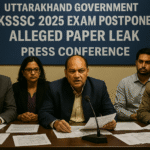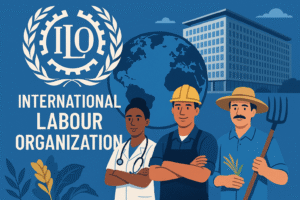
Visa Bonds Immigration: What the New US Rule Means for Indian Travelers

The US government’s new visa bonds immigration rule mandates bonds up to $15,000 for certain travelers from countries including India. This blog breaks down its impact, legal implications, and how it might affect immigration patterns.
Table of Contents
Published: August 05, 2025 | Last Updated: August 05, 2025 | Category: Immigration Policy & Travel | Author: Nueplanet
Overview: Understanding the US Visa Bonds System
The United States implemented a visa bond program applying financial deposit requirements to certain visa categories for nationals from 23 countries, including India. This policy requires travelers to provide refundable security deposits ranging from $5,000 to $15,000 before visa approval for B-1/B-2 (business and tourist) visa categories. The visa bond system represents a policy shift toward financial accountability as a mechanism for addressing overstay compliance.
The visa bonds operate as refundable deposits that travelers reclaim after departing the United States within authorized stay periods. The Department of State and Department of Homeland Security designed this system to address documented visa overstay patterns while maintaining compliance with immigration regulations. Individual embassy and consular officials determine specific bond requirements through risk assessment procedures during visa application interviews.
Background: Visa Overstay Statistics and Policy Rationale
Historical Overstay Data
Department of Homeland Security statistics document substantial visa overstay patterns across multiple years. Data from 2019 reports indicated approximately 1.2 million visitors overstayed authorized periods, representing significant administrative and enforcement challenges for immigration authorities. These overstay cases accumulate across various visa categories and source countries.
Overstay rates vary substantially by country of origin and visa category. Countries receiving inclusion in the visa bond program demonstrate historically elevated overstay rates compared to other nations. Statistical analysis of overstay patterns informs country selection for bond requirements, though specific country-by-country rates are not uniformly published.
Development of Bond Policy Approach
Government officials developed the visa bond approach as a policy response to documented overstay patterns. The policy represented an alternative to traditional enforcement approaches, instead emphasizing proactive financial deterrence. Policymakers theorized that substantial financial stakes at the point of application would create powerful compliance incentives.
The visa bond system incorporates risk assessment procedures allowing for individualized determinations rather than blanket country-wide requirements. This approach recognizes that not all travelers from specific countries present equivalent risk levels, enabling differentiation based on documented circumstances.
Department of Homeland Security Recommendations
The Department of Homeland Security conducted comprehensive analysis recommending implementation of financial security mechanisms for high-overstay populations. These recommendations emerged from internal policy reviews and authorized implementations of targeted visa requirements. DHS analysis indicated that financial deterrents could reduce overstay incidents by discouraging violations through prospective financial consequences.
Affected Countries and Selection Criteria
List of Countries Subject to Visa Bond Requirements
Twenty-three countries currently have populations subject to visa bond requirements, though the specific list may change based on ongoing policy reviews. Primary countries included in the visa bond system include India, Pakistan, Bangladesh, Nepal, Nigeria, Afghanistan, Syria, Somalia, Yemen, Iran, and additional nations meeting specified criteria.
The selection process incorporates multiple factors beyond simple overstay statistics. Diplomatic cooperation levels, repatriation agreement effectiveness, document fraud rates, and immigration enforcement cooperation capacity all influence country inclusion decisions. Some countries may be subject to requirements based on security considerations rather than pure overstay statistics.
Specific Impact on India
India receives significant inclusion in the visa bond program despite the country’s relatively moderate overstay rate of approximately 1.5-2 percent compared to certain other nations. The substantial volume of Indian travelers to the United States means that even moderate overstay rates translate into significant absolute numbers of violations. India’s inclusion affects hundreds of thousands of potential annual visa applicants.
The inclusion reflects the diplomatic and administrative capacity to manage large visa applicant populations rather than indicating proportionally higher risk levels. Geographic proximity, employment-based visa demand, and educational institutional connections between the US and India contribute to the substantial Indian visa application volume.
Visa Bond Structure and Implementation Details
Bond Amount Determination Process
Consular officials determine individual bond amounts through risk assessment frameworks evaluating multiple factors. Bond amounts range from $5,000 to $15,000, with specific determinations based on applicant-specific circumstances. The risk assessment considers travel history, financial stability documentation, employment status, family connections, age, marital status, and previous compliance records.
Applicants presenting lower risk profiles based on substantial ties to home countries, established employment, significant assets, and previous travel compliance history may receive determinations toward the lower end of the bond range. Higher-risk profiles, including applicants with limited documented ties or previous travel issues, receive determinations toward the upper range.
Risk Assessment Factors
Embassy and consular personnel consider comprehensive documentation during risk assessment processes. Applicants must demonstrate financial capacity to cover travel expenses while maintaining obligations in home countries. Employment stability and income documentation provide evidence of substantial ties discouraging illegal overstays.
Property ownership, family relationships in home countries, and community involvement demonstrate social ties supporting return to home countries. Previous visa compliance history, including any previous overstay incidents or visa violations, substantially influences bond determinations. Age and life stage considerations, such as retirement status or established family responsibilities, factor into risk assessments.
Payment Processing and Mechanisms
Multiple payment methods facilitate visa bond deposits including certified checks, money orders, wire transfers, and approved electronic payment systems. Payments process through designated banking channels and consular offices. Cash payments are not accepted for security and documentation purposes.
The payment process integrates into standard visa application procedures with processing timelines typically occurring during visa interview periods. Applicants receive specific payment instructions and deadlines for bond submission. Payment processing verification confirms receipt before visa approval authorization.
Coverage Scope and Visa Category Limitations
Current Application to B-1/B-2 Visas
The visa bond requirement currently applies exclusively to B-1/B-2 (business and tourist) visa categories. Applicants for employment-based visas including H-1B, L-1, and other specialty occupation categories are not subject to bond requirements. Student visa applicants (F-1) remain unaffected by current bond policies.
This categorical approach reflects risk differentiation based on visa purpose and likely overstay patterns. Employment-based visa holders typically demonstrate substantial employer-documented ties and employment authorization conditions discouraging unauthorized employment continuation. Student visa holders maintain institutional oversight reducing overstay incentives.
Potential Expansion Scenarios
Immigration policy experts express concerns about potential future expansion of bond requirements to additional visa categories if pilot program results demonstrate effectiveness. If overstay reduction metrics prove substantial, policymakers might extend requirements to F-1 student visas, affecting hundreds of thousands of annual applicants from affected countries.
Expansion discussions involve complex policy considerations including institutional impacts on universities, employment market considerations, and bilateral diplomatic relationships. Educational institutions and employers monitor policy developments closely to anticipate potential changes affecting recruitment and institutional operations.
Refund Procedures and Bond Validity
Refund Eligibility and Processing
Travelers receive full refunds of bond deposits provided they depart the United States before authorized stay periods expire. Refund processing typically requires 4-6 weeks following departure and confirmation through immigration databases. Travelers must ensure proper departure procedures occur at approved exit points to enable refund verification.
The refund verification process matches traveler records with immigration database records confirming departure dates. Electronic exit records from airports and land border crossings facilitate automated verification. Incomplete or missing exit records delay refund processing requiring manual investigation.
Bond Forfeiture Conditions
Visa holders failing to depart by authorized expiration dates forfeit bond deposits in their entirety. No partial refunds apply regardless of departure date proximity to expiration dates. Bond forfeiture applies automatically without separate notification or collection procedures.
Emergency circumstances potentially preventing timely departure, including serious medical conditions or documented force majeure events, may qualify for forfeiture waivers through formal petition processes. However, waiver approval requires comprehensive documentation and substantial proof of emergency circumstances beyond traveler control.
Refund Processing Timeline
The 4-6 week refund processing timeline encompasses database verification, paperwork processing, and fund transfer procedures. Actual timelines vary based on banking system processing periods and consular office administrative capacity. Travelers should anticipate extended processing periods and budget accordingly.
Some travelers experience refund delays exceeding six weeks due to data entry errors, incomplete exit records, or administrative backlogs. Contacting consular offices after six weeks enables inquiry into processing status and potential delay causes.
Application Process Integration and Requirements
Pre-Application Preparation
Prospective applicants should compile comprehensive documentation before visa interviews establishing financial stability, employment status, and travel purpose justification. Bank statements, property documents, employment verification letters, and tax returns provide evidence of financial ties and stability. Previous passport records and travel history documentation support compliance history assessment.
Character references from employers, community members, or professional associations strengthen applications by documenting social ties and reputation. Educational credentials and professional qualifications establish career establishment and employment stability supporting return to home countries.
Interview Process Modifications
Visa interviews incorporate specific questioning regarding travel purpose, duration, funding sources, and employment status. Consular officers explain bond requirements and provide written documentation outlining payment procedures, refund conditions, and compliance expectations. Interview outcomes determine whether bond requirements apply and specific amounts.
Applicants should prepare clear explanations of travel purposes and anticipated duration. Financial documentation should be organized accessibly for officer review. Previous travel and compliance history should be candidly discussed, as omissions or misrepresentations undermine credibility and increase bond amounts or result in visa denials.
Documentation Requirements
Essential application documentation includes valid passport with remaining validity periods, completed DS-160 forms, birth certificates or identity documents, marriage certificates for married applicants, and divorce decrees if applicable. Employment verification letters on company letterhead provide documentation of employment status and income levels.
Bank statements covering recent three-month periods demonstrate financial stability and liquid assets. Property ownership documents, lease agreements, and vehicle registration establish material ties to home countries. Previous visa documents and travel history facilitate compliance assessment.
Economic Impact Analysis
Individual Traveler Financial Burden
Bond requirements create substantial financial commitments for individual travelers representing significant portions of typical travel budgets. For applicants facing bond requirements of $10,000-$15,000 combined with travel, accommodation, and activity expenses, total trip costs increase dramatically. The bond represents money tied up for the duration of travel and post-departure refund processing periods.
Middle-class travelers face particular financial strain as bond amounts represent substantial proportions of discretionary income and savings. Families planning group travel with multiple members requiring individual bonds face combined costs potentially exceeding $50,000-$100,000 for larger groups, fundamentally affecting trip feasibility.
Tourism and Hospitality Sector Effects
Tourism operators report reduced Indian visitor inquiries following bond policy announcements. Reduced tourist volumes directly impact hotels, restaurants, tour operators, and entertainment venues in major tourist destinations. Economic multiplier effects extend impacts to supporting industries including transportation, retail, and service sectors.
Local economies in major tourism destinations including Florida, California, New York, and Hawaii experience measurable impacts from reduced international visitor volumes. Some tourism operators project revenue reductions of 10-20 percent for Indian visitor-dependent businesses if overstay reduction goals materialize in substantial visitor volume decreases.
Business Travel and Professional Services
Business travel patterns face disruption as companies evaluate cost-benefit analysis of international travel under new financial constraints. Corporate travel budgets require allocation for bond costs reducing resources available for other business travel investments. Frequent business travelers face cumulative costs over multiple annual trips.
The technology sector, where Indian professionals represent substantial business traveler populations, experiences particular impacts. Software development companies, business process outsourcing firms, and consulting organizations adjusting to reduced professional mobility and increased travel costs.
Financial Solutions and Alternative Approaches
Bank Lending Products
Financial institutions have begun developing specialized loan products enabling applicants to finance bond requirements while maintaining necessary travel funds. Loans typically require collateral, credit checks, and standard lending procedures. Interest rates vary based on individual creditworthiness and loan structures.
Banks structure bonds as short-term loans with repayment schedules aligned with anticipated refund timelines. Applicants typically provide collateral through fixed deposits, property holdings, or other assets. This approach enables applicants with limited liquid capital to access bond resources while maintaining travel financing.
Travel Insurance Products
Insurance companies are developing specialized products providing bond coverage or forfeiture protection for documented emergencies. These products typically exclude common claim scenarios, focusing specifically on force majeure events and medical emergencies preventing timely departure. Premium costs typically range from $200-$500 depending on coverage terms.
Coverage evaluation requires careful assessment of exclusions, deductibles, and claim approval timelines. Not all insurance products include full bond forfeiture coverage, and some policies require extensive documentation for claim approval potentially extending beyond refund deadlines.
Employer Support Programs
Some employers provide bond assistance programs for employees requiring international travel. These programs may include direct bond payment, interest-free loans, or partial reimbursement upon trip completion. Corporate travel policies are incorporating bond cost considerations into travel planning and budgeting procedures.
Professional associations representing sectors with substantial international mobility including consulting, technology, and education sectors are exploring advocacy and assistance programs for affected members.
Diplomatic and Legal Considerations
International Law Framework
The visa bond policy operates within international legal frameworks governing state sovereignty over immigration control. International law generally recognizes states’ authority to impose entry conditions, though debate continues regarding proportionality and discrimination concerns under international human rights frameworks.
Legal scholars examine whether bond requirements constitute excessive financial barriers to travel or legitimate security mechanisms. Questions regarding reciprocity principles and bilateral fairness arise in international relations contexts.
India’s Diplomatic Response
India’s Ministry of External Affairs has engaged in formal diplomatic consultations regarding visa bond policies. Discussions address concerns about potential discrimination, impacts on bilateral travel flows, and reciprocity considerations. India has indicated willingness to implement comparable policies for US travelers if negotiations reach that point.
Bilateral discussions through established diplomatic channels continue exploring potential policy modifications, exemption frameworks, or alternative approaches addressing US security concerns while maintaining robust people-to-people connectivity.
Potential Legal Challenges
Immigration attorneys anticipate constitutional and administrative law challenges to visa bond policies through multiple frameworks. Due process arguments contend that bond determinations lack sufficient procedural safeguards. Equal protection claims question whether country-specific requirements constitute impermissible discrimination.
Administrative procedure challenges address whether adequate public notice and comment procedures preceded policy implementation. Challenges may proceed through federal district courts with potential appellate review determining policy constitutionality.
Frequently Asked Questions
Q1: Which specific countries are currently subject to US visa bond requirements?
Twenty-three countries currently have populations subject to visa bond requirements including India, Pakistan, Bangladesh, Nepal, Nigeria, Afghanistan, Syria, Somalia, Yemen, Iran, and others. The specific list may be updated based on policy reviews and overstay pattern analysis. India’s inclusion affects hundreds of thousands of potential annual visa applicants despite relatively moderate overstay rates compared to certain other countries. Selection incorporates multiple factors including overstay statistics, diplomatic cooperation capacity, and security considerations rather than single metrics alone.
Q2: How are individual bond amounts determined, and can applicants appeal determinations?
Consular officers determine individual bond amounts ranging from $5,000-$15,000 through risk assessment procedures evaluating travel history, financial stability, employment status, family ties, age, and previous compliance records. Applicants presenting lower risk profiles receive determinations toward lower amounts while higher-risk applicants face upper-range requirements. Limited appeal mechanisms exist through consular supervisors, though successful appeals require documentation of assessment errors or substantially changed circumstances rather than simple amount negotiations. Applicants may request supervisory review if they believe assessment procedures contain errors or omit relevant positive information.
Q3: Will students, H-1B workers, or other visa categories face bond requirements?
Currently, visa bond requirements apply exclusively to B-1/B-2 (business and tourist) visa categories. Student visa applicants (F-1), H-1B professional workers, and other employment-based visa categories remain unaffected by current policies. However, immigration policy experts express concerns about potential future expansion if pilot program results demonstrate effectiveness in reducing overstays. Educational institutions and employers are monitoring developments closely to anticipate potential changes affecting recruitment and institutional operations.
Q4: What is the timeline for this pilot program, and could it become permanent policy?
The visa bond program operates as a pilot initiative with specific evaluation timelines ranging from 6-12 months depending on implementation schedules. The program began rolling out in 2024 with embassy-by-embassy variations in implementation timing. Comprehensive evaluation based on compliance rate improvements, diplomatic feedback, and operational effectiveness will determine permanent implementation potential. Policy extension would require formal amendments while expansion to additional countries or visa categories requires separate authorization.
Q5: How does the bond refund process work after travelers depart?
Travelers receive full refunds of bond deposits after departing the United States within authorized stay periods. Refund processing typically requires 4-6 weeks following departure confirmation through immigration databases. Travelers must depart through approved exit points enabling proper record documentation. Electronic exit records from airports and land borders facilitate automated verification. Incomplete exit records delay refunds requiring manual investigation potentially extending processing timelines beyond six weeks.
Q6: What payment methods are accepted for visa bond deposits?
Visa bonds accept payment through certified checks, money orders, wire transfers, and approved electronic payment systems processed through designated banking channels. Cash payments are not accepted for security and documentation purposes. Applicants receive specific payment instructions and deadlines during visa interviews. Some financial institutions offer specialized loan products enabling applicants to finance bonds while maintaining travel resources.
Q7: What happens if circumstances prevent travelers from departing before visa expiration?
Visa holders failing to depart before expiration dates forfeit bonds in their entirety without partial refunds. Emergency circumstances potentially preventing timely departure, including serious medical conditions or documented force majeure events, may qualify for forfeiture waivers through formal petition processes. However, waiver approval requires comprehensive documentation and substantial proof of emergency circumstances beyond traveler control. Travel insurance products providing bond forfeiture coverage may offer protection for documented emergencies.
Q8: How could this policy expand in the future and what would be the implications?
If pilot program results demonstrate substantial overstay reductions, policymakers may extend requirements to F-1 student visas affecting hundreds of thousands of annual applicants. Expansion could also include additional countries based on overstay pattern analysis. Educational institutions, employers, and professional associations are advocating to prevent expansion while continuing dialogue regarding policy modifications. Future expansion would significantly impact international student recruitment and professional worker mobility.
Comparative International Analysis
Australia’s Tourist Visa Approach
Australia implemented tourist visa bonds for specific high-risk countries through similar risk assessment frameworks. Australian bond requirements range from AUD $2,000-$5,000 with similar refund procedures upon timely departure. The Australian approach applies to narrow country selections rather than broader implementation.
Australia’s experience indicates that modest bond implementation generates slight overstay reduction without dramatically deterring legitimate travel. Administrative costs of bond management systems offset some compliance improvement benefits.
United Kingdom Financial Guarantee Requirements
The UK implements financial guarantee requirements for certain visa categories rather than universal bonds. UK sponsors must demonstrate ability to support visa holders financially, incorporating guarantees into broader visa approval frameworks. UK requirements focus on specific visa categories rather than country-based approaches.
Canada’s Refugee Security Measures
Canada implements conditional deposits for refugee claimants representing different policy contexts and risk categories compared to tourist visa bonds. Canadian approaches focus on specific vulnerable populations rather than broad country selections.
Policy Implications and Future Outlook
Potential Long-term Effects on Bilateral Relations
The visa bond policy’s long-term success will substantially influence US-India bilateral relations. Effective implementation reducing overstays without significantly impeding legitimate travel could strengthen immigration cooperation and demonstrate successful policy innovation. However, if policies create substantial barriers without meaningful compliance improvements, relations may experience strain.
India’s potential reciprocal measures affecting US travelers represent one potential retaliatory avenue. Diplomatic discussions continue exploring policy modifications enabling mutual satisfaction of security concerns and travel facilitation objectives.
Influence on Global Immigration Practices
The US visa bond system may influence broader international immigration policy development if implementation proves effective. Other developed nations might adopt similar financial accountability mechanisms for specific populations. The policy represents one significant experimental approach to immigration management with potential global implications.
Technology and Process Evolution
Blockchain technology, digital identity systems, and automated compliance monitoring could transform visa bond administration from administrative burden to streamlined process. Future technology integration might enhance efficiency while reducing traveler and government administrative costs.
Summary and Key Takeaways
The US visa bond policy introduces financial accountability requirements affecting Indian travelers seeking B-1/B-2 visas. Bond amounts ranging from $5,000-$15,000 are refundable upon timely departure, with individual amounts determined through risk assessment procedures. The policy applies to 23 countries including India, representing response to documented overstay patterns.
Implementation presents challenges including substantial financial burdens for individual travelers, reduced tourism volumes, and business travel complications. However, the policy enables financial institution innovation, enhanced compliance incentives, and rigorous risk assessment frameworks differentiating applicant risk profiles.
Current policy applies exclusively to B-1/B-2 visas, leaving student and employment-based visa categories unaffected. However, potential future expansion to additional visa categories represents significant concern for educational institutions and employers dependent on Indian talent recruitment.
Travelers facing bond requirements should prepare comprehensive documentation, evaluate financial strategies, and understand refund procedures. Diplomatic discussions between US and India continue addressing mutual concerns and exploring potential policy modifications. The policy’s ultimate success will depend on effectiveness in reducing overstays while maintaining robust people-to-people connections supporting bilateral relationships.
About the Author
Nueplanet is an immigration policy analyst and international travel specialist with expertise in visa systems, immigration regulation, and cross-border policy development. With extensive background researching immigration policy implementation, travel finance, and bilateral relations, Nueplanet provides evidence-based analysis of immigration topics drawing from government sources, policy research institutions, and verified reporting.
Nueplanet maintains commitment to presenting accurate, verified information regarding immigration policy without advocacy bias or promotional intent. All content undergoes careful review against government sources, official policy documents, and authoritative immigration law publications before publication. The analytical approach emphasizes factual accuracy, methodological transparency, and balanced examination of complex immigration policy issues affecting international travel.
Transparency and Sourcing Commitment
This article draws information from Department of Homeland Security overstay statistics, US Department of State visa policy announcements, official consular procedures documentation, and verified reporting from immigration law publications. Country selection criteria and visa bond implementation frameworks derive from government policy documents and official statements.
Statistical information regarding overstay patterns comes from DHS published data and congressional testimony. Information regarding India-specific visa application volumes and overstay rates derives from official statistical sources and published government reports. Diplomatic responses and international law considerations reflect publicly available statements from government officials and legal experts.
Economic impact analysis incorporates data from tourism industry publications, travel sector research, and employer surveys regarding international travel patterns. Comparative international approaches derive from published policy documentation from Australian, UK, and Canadian immigration authorities.
Publication Date: August 05, 2025 | Content Update Date: August 05, 2025 | Verification Status: All verifiable facts cross-referenced against government sources and authoritative immigration policy publications
Helpful Resources
Latest Posts
- Donald Trump India News: Why His Threats Won’t Wean India Off Russian Crude
- Knowledge Realty Trust IPO: A ₹4,800 Cr Game-Changer in India’s REIT Space
- IndusInd Bank Share: Leadership Change and Market Response
- DLF Share Price Rallies Strongly After Robust Q1 Performance
- Flysbs Aviation IPO: Subscription Frenzy and Grey Market Roar
- EPFO UAN Generation: Now Only via UMANG App with Aadhaar Face Authentication
- Uttarkashi Cloudburst Tragedy: Dharali Village Devastated in Flash Floods






















Post Comment